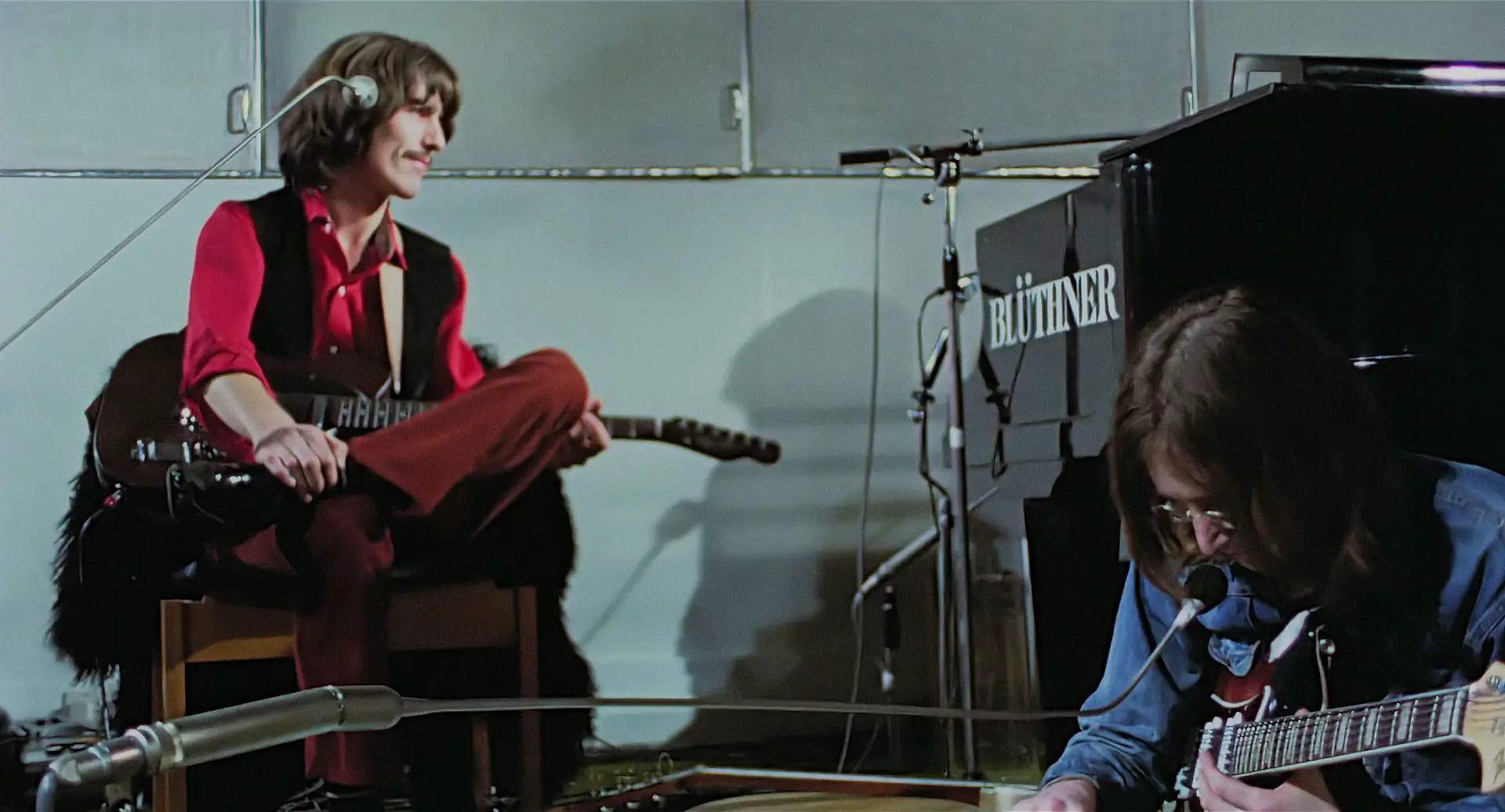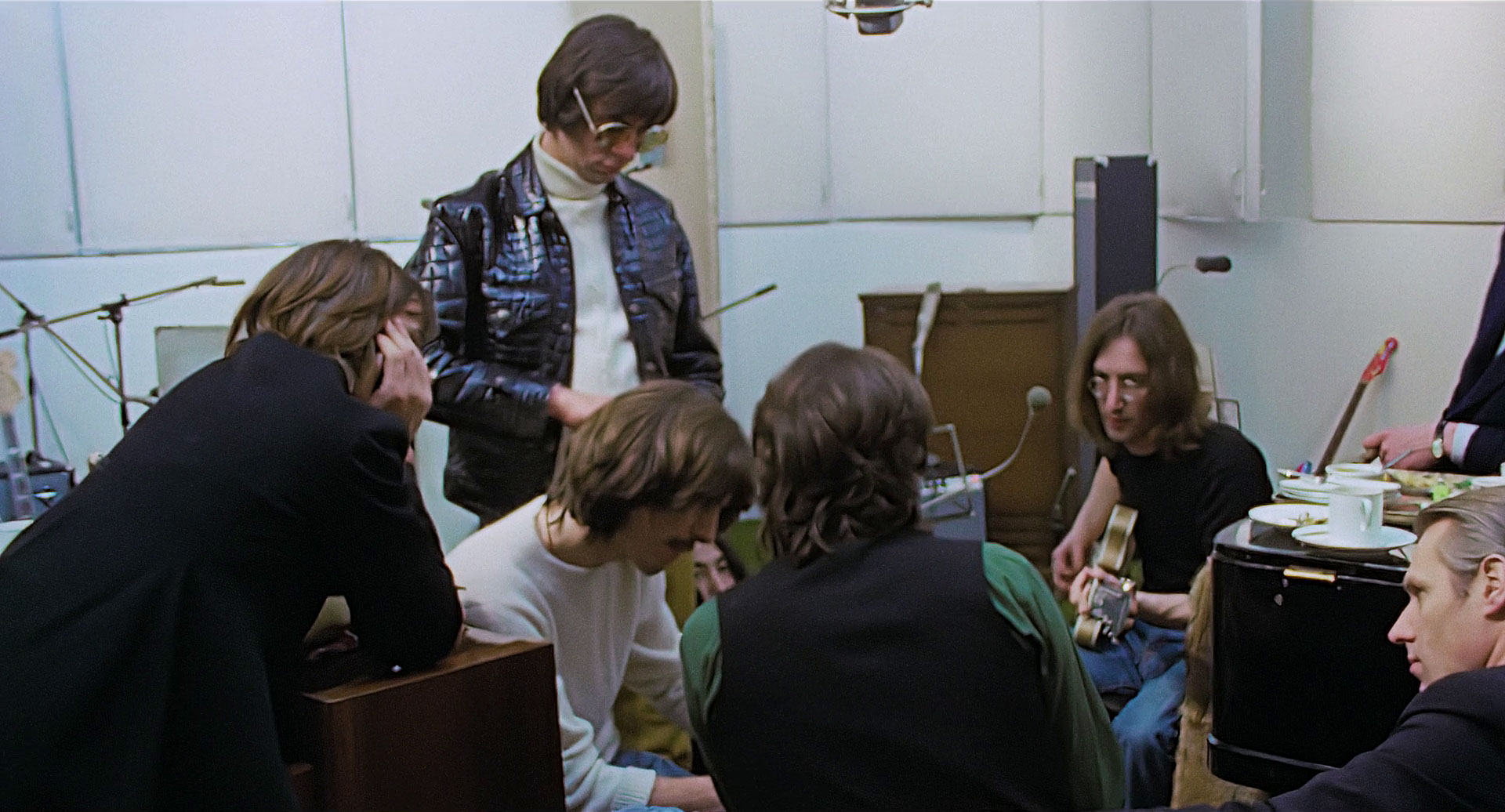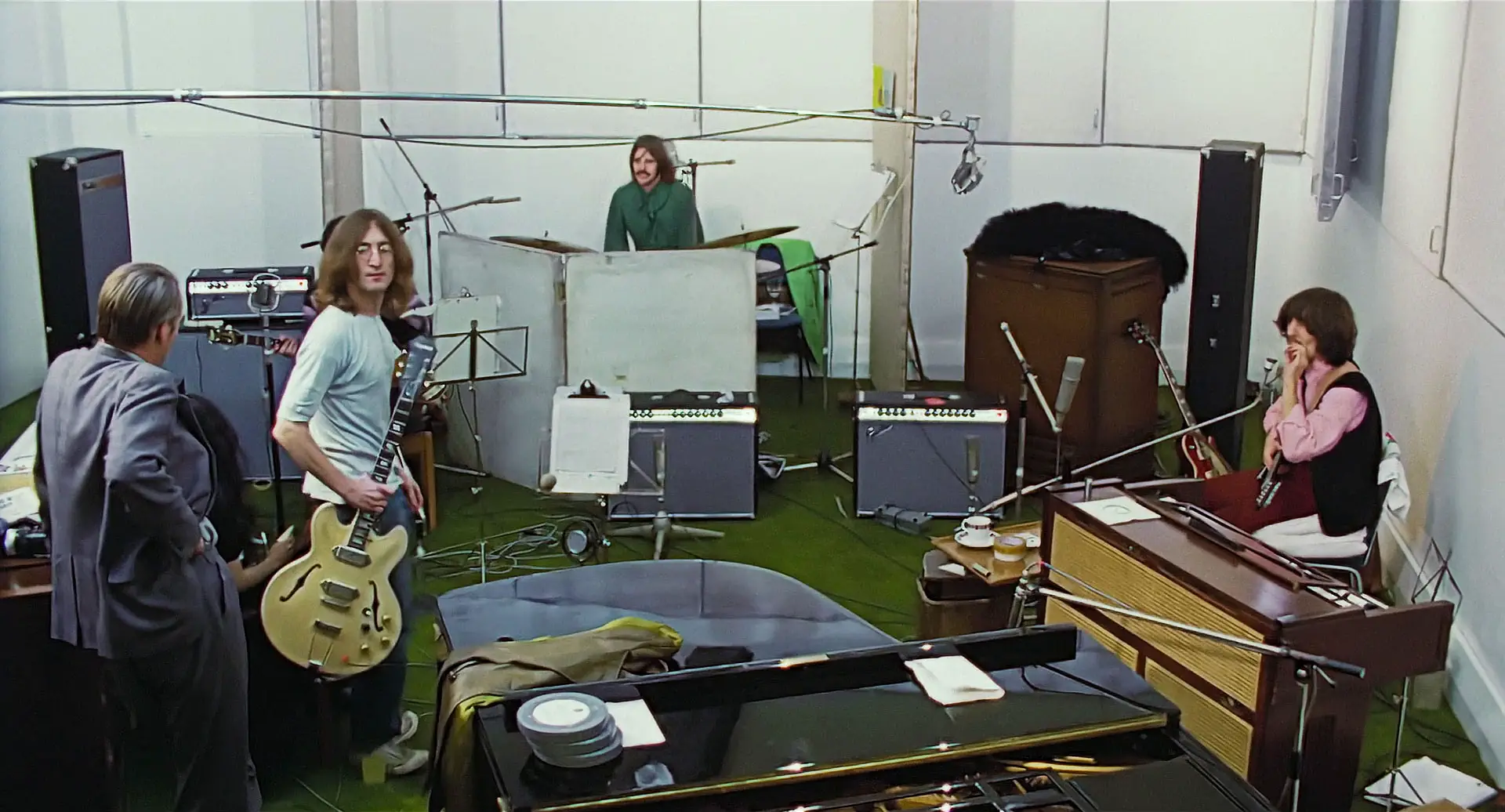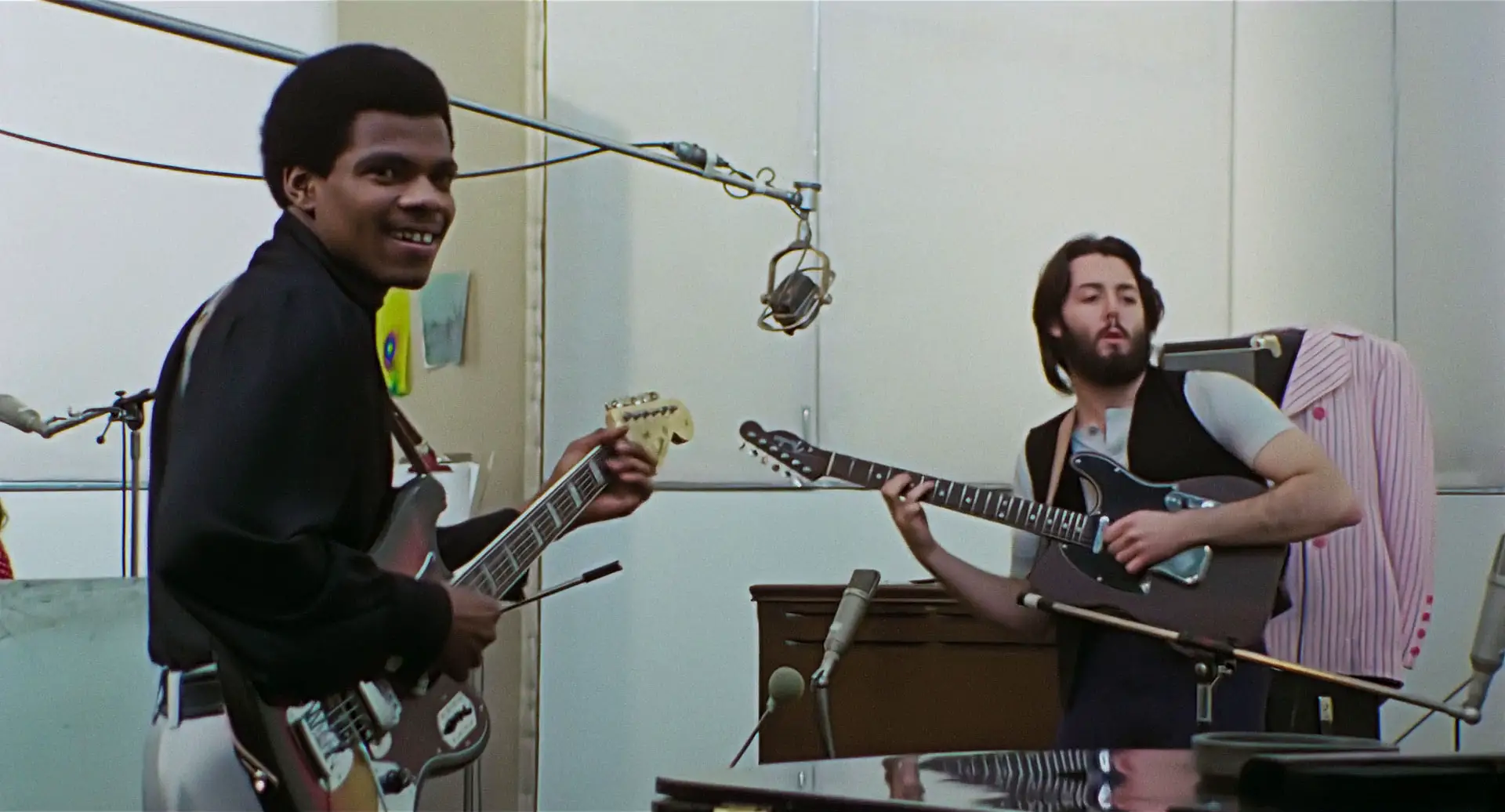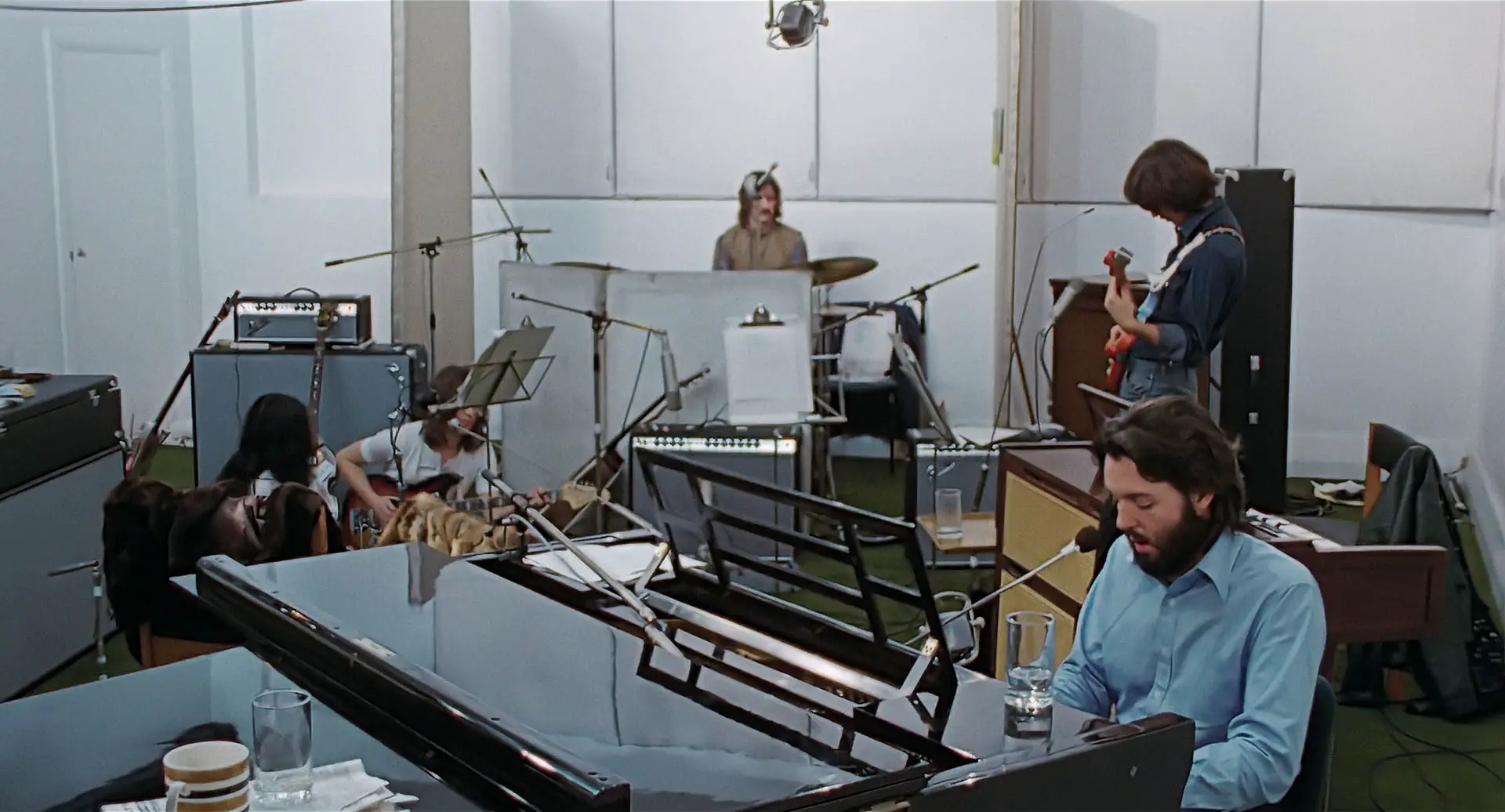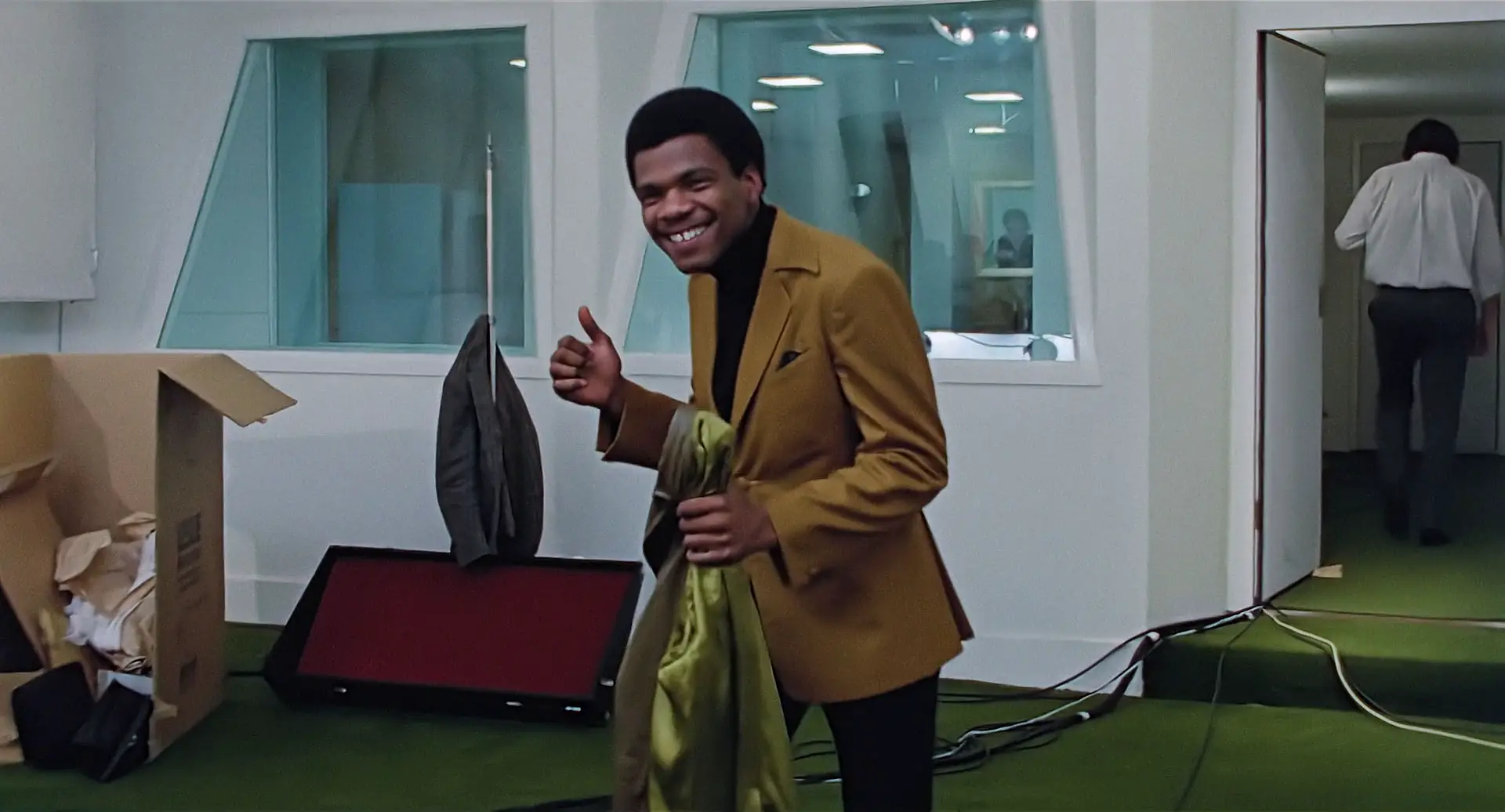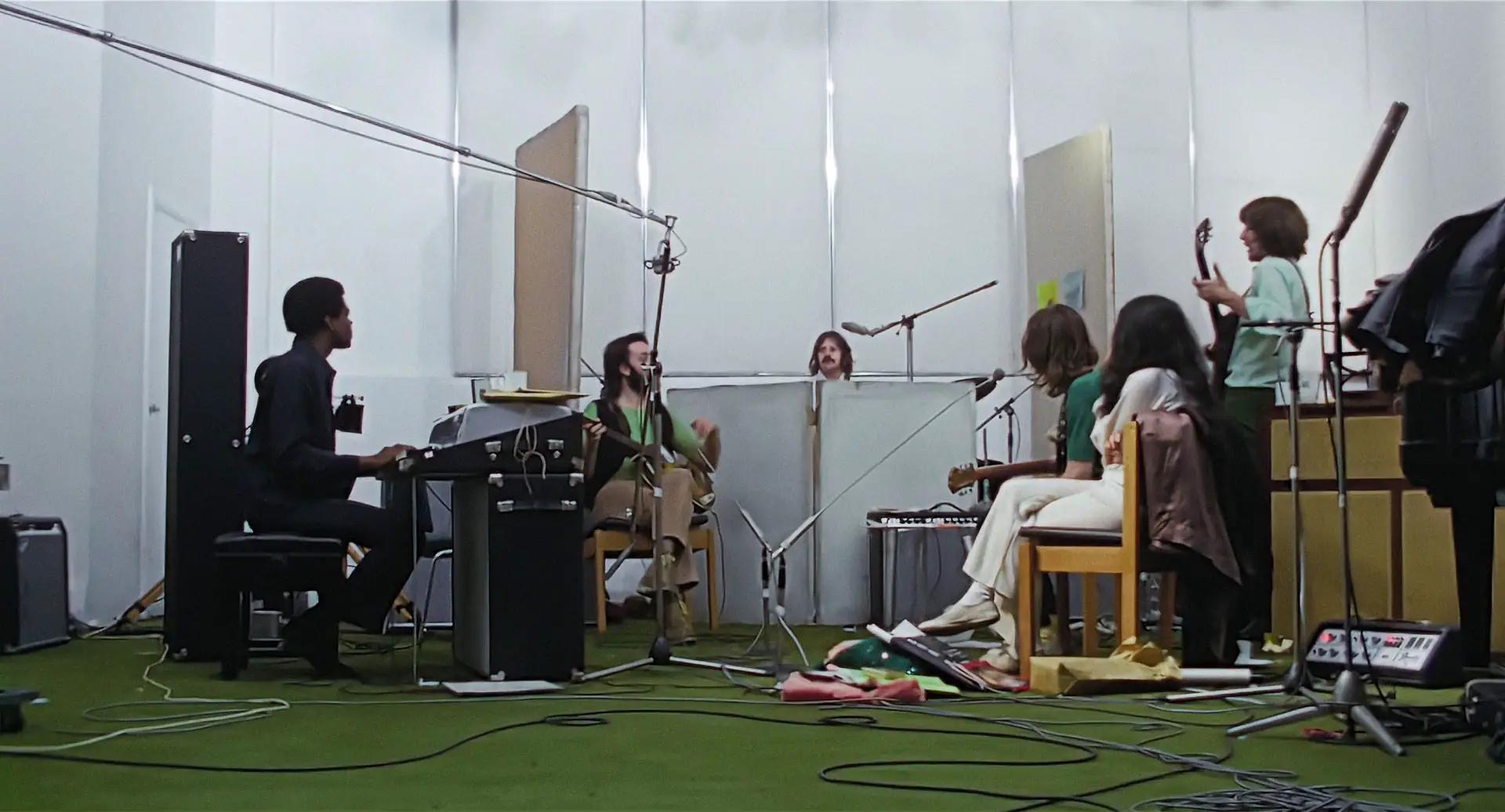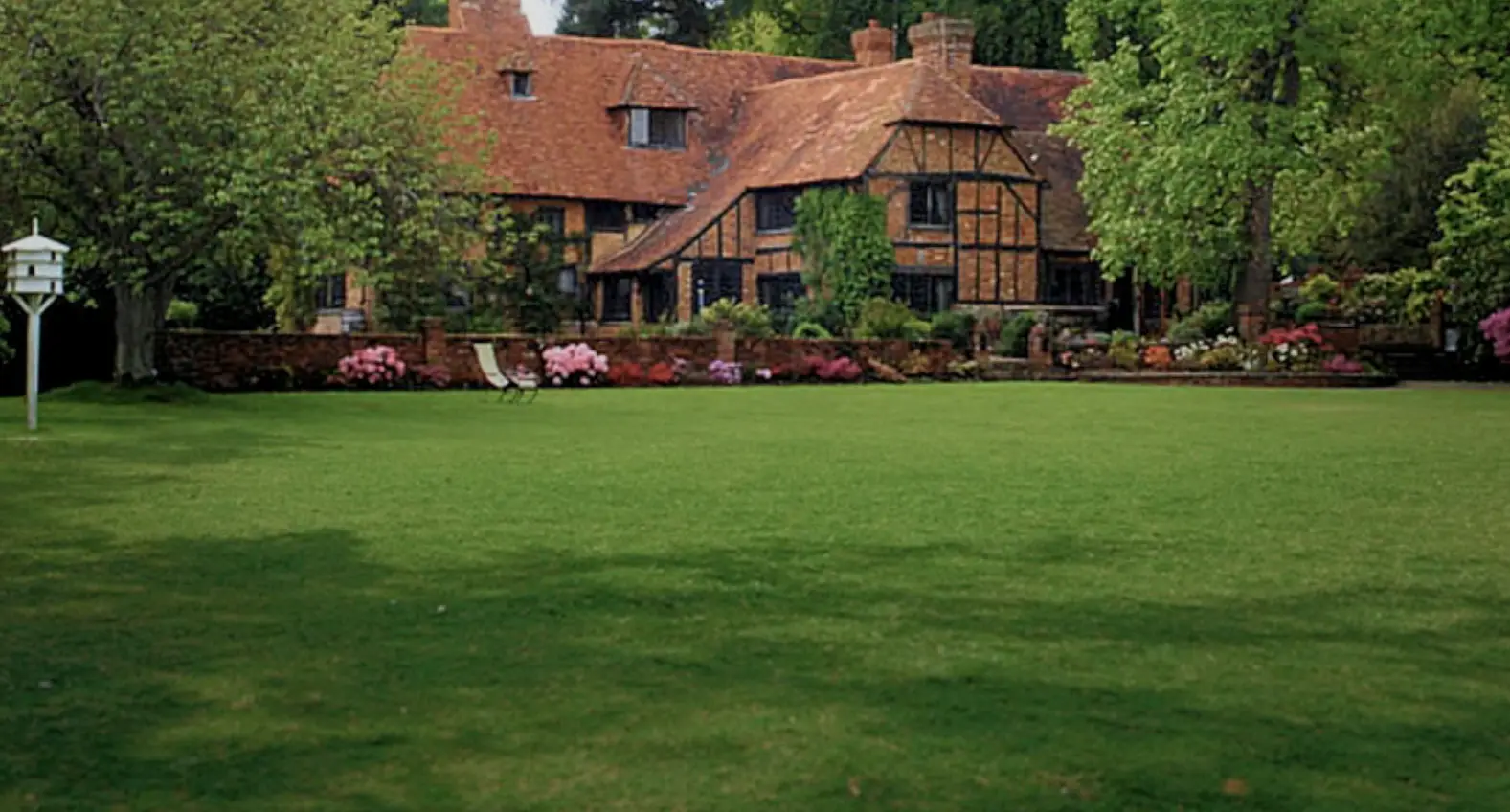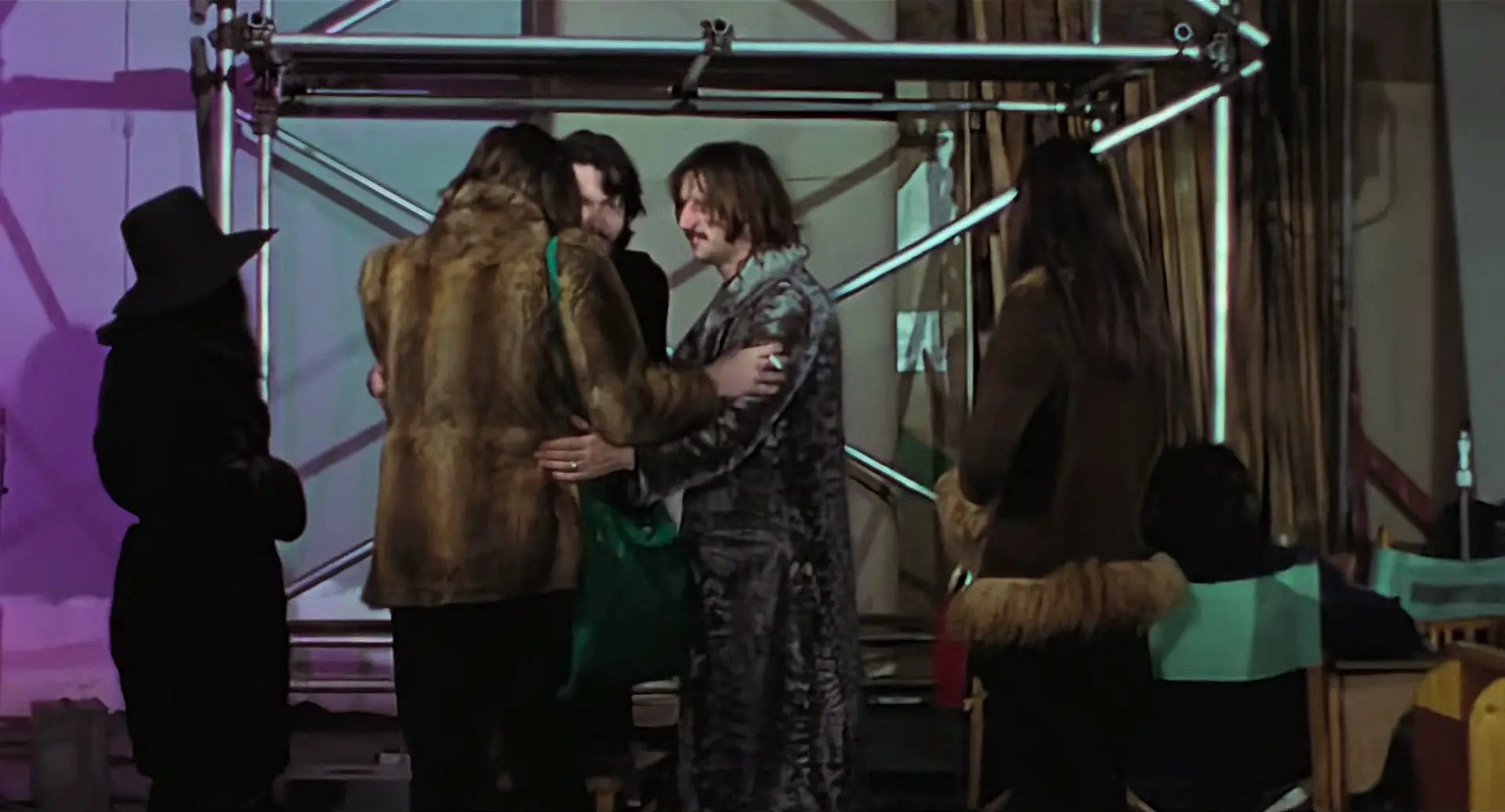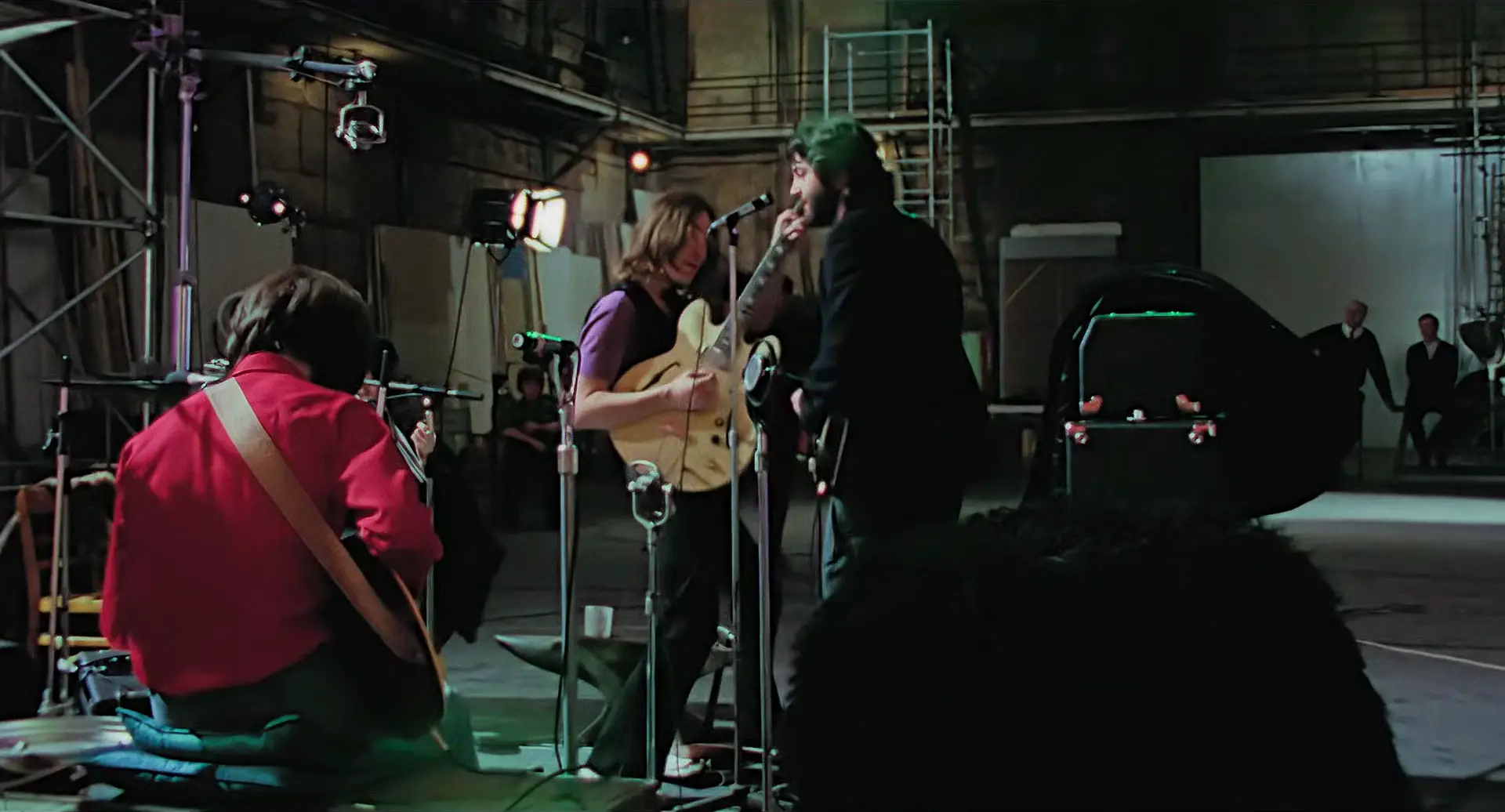The onscreen calendar is circled for today, with “ROOFTOP CONCERT” written in pen. The captions explain the camera setup: five on the roof, one across the street, three at street level, and one said to be “hidden” in the lobby of the Apple building. Hilariously, George Martin sees this camera as soon as he walks in and smirks at it. He will be down in the basement control room with Glyn, connected to the rooftop via recording cables and a closed-circuit television camera—high-tech sh-t for the time.
While all this is being set up, the captions explain that the Beatles are in a meeting, still undecided about playing on the roof. They also introduce receptionist Debbie Wellum and doorman Jimmy Clark—sporting quite the mod hairstyle—who will be prominent throughout today’s footage. Down in the street it’s lunch hour, with heavy automobile traffic and pedestrians moving about. Being January in London it’s cold, and windy, but not frigid; reports say it was a relatively mild winter.
Suddenly, Paul appears in the doorway leading onto the roof, which is covered with long wooden planks to support all the people and equipment. He’s followed shortly by Ringo and Maureen, then Billy. Ringo gets to work moving his drums, suggesting that Mal “nailed me down in the wrong place” as George and John appear. The onstage setup is slightly different from how they used to do concerts, and even from the “Revolution” promo clip; Paul is basically in front of Ringo, with John to his left and George on the other side of John. Billy is at the electric piano to Paul’s right, by the door. Yoko is seated at the side next to Maureen, Chris O’Dell, and Apple Records exec Ken Mansfield. (Apple “house hippie” and press liaison Richard DiLello’s fuzzy head can be glimpsed briefly in the doorway.) There is a Hohner keyboard set up behind George, but it will not be used.
After a quick count-off, they launch into a quick rehearsal of “Get Back”, intercut with crowd reaction. The people on the street can hear the music, and see some of the light towers at the top of the building, but they can’t see the band from that angle. However, spectators are gathering on neighboring buildings to watch.
Here Jackson’s edit begins to switch in and out of split-screen to utilize as many camera angles as possible, on the roof as well as in the street. John impatiently says, “Come on, youse idiots,” and George counts off the first full performance of “Get Back”. Before the first chord change, Paul breaks into a wide grin that stays for the entire song. We can see Kevin digging the sound too, and Maureen is happily bopping her head, just as she likely did back when they played the Cavern every lunchtime.
They cut filming on the roof to adjust sound levels, and the cameras on the street capture reactions from pedestrians, which are mostly positive. The sound presumably sorted out, and the band suitably warmed up—except for John, who blows on his chilled fingers any chance he gets—they go into another performance of “Get Back”. They’re all smiling, even George, and moving to the rhythm.
A terrific performance of “Don’t Let Me Down” with full three-part harmonies is arguably marred when John completely garbles the first line of the third verse. The split-screen shows George and Michael both laughing at this, and then Ringo. John recovers for the next line, in perfect sync with Paul’s harmony. (This remains our absolute favorite performance of this song.) We also hear the first negative comment on the street, specifically about the volume of the music, and two policemen make their way up the steps to the Apple lobby. One is identified as PC Ray Dagg; the Internet tells us that his official title was Police Constable 574C, and that he was all of 19 years old. The other is PC Ray Shayler, PC 637C and a veteran at 25.
The band goes straight into “I’ve Got A Feeling” as the police knock on the front door of the building; it is, after all, private property and they can’t just barge in. While the song plays on the left frame, in the right frame PC Dagg explains to Jimmy that there have been “30 complaints in the past half-hour”—which is odd because they’ve only been playing for ten minutes—about the alleged “breach of peace”. He doesn’t realize that they’re on the roof; he thinks they’re just being loud. Debbie the receptionist plays dumb, saying they’re trying to find Derek Taylor. (This is the take of “I’ve Got A Feeling” that will open side two of the Let It Be album, which is one thing Phil Spector got right.)
Paul acknowledges the cheers from across the street, and John, George, and even Ringo approach the edge of the roof to see all the people gathered on the pavement below. In the background, we see Jimmy talking with Mal, Michael, and Peter Brown, who’s been lurking in the doorway. In the street, a vicar gives his endorsement, while younger folks express their varying approval and disapproval, and one older woman straight out of a Monty Python sketch complains she was woken from her sleep.
Tony works the clapper for the cameras, and it’s right into “One After 909” as Apple exec Ron Kass appears in the background; George Martin can be seen at one point as well. This take is one of the very few of all the versions, in 1969 as well as 1963, where John didn’t screw up the bridge back to the verse. Glyn chose it to open his proposed Get Back LP, and Phil Spector would include it on the Let It Be album, directly after “I’ve Got A Feeling” and with the closing “Danny Boy” ad-lib intact.
Down in the lobby, PC Dagg is on the phone to the police station for reinforcements, while John looks for the words to “Dig A Pony”. They’re on a clipboard, but there’s no music stand available, so Kevin will be immortalized on film kneeling at John’s feet holding the lyrics for him to see. Before the song starts, Mal is down in the lobby appealing to the police, and only after this do the bobbies realize the band is on the roof in the open air, and PC Dagg gets back on the phone.
After a false start because Ringo hasn’t put out his cigarette, they kick into “Dig A Pony”. When included on the Let It Be album, this false start will be included, as well as John’s closing comment about his hands getting too cold, but the sung “all I want is” intro will be edited out. Meanwhile, more pedestrians in the street express their enjoyment, and Mal tells the police in the lobby that he’s lowered the PA volume. (Apple publicist Jack Oliver can also be seen briefly in the roof doorway.)
George suggests they play “Dig It”, of all things, while the camera shows more support from Beatle fans of all ages at street level. To accommodate a tape change in the basement, the band jams on “God Save The Queen”, heard (and seen) here for the first time ever. Once film and sound are in sync again, they have another pass at “I’ve Got A Feeling”. George is more vocally audible on this one, and he adds some extra guitar flourishes to John’s jumbled verse. There’s a wonderful moment where we see the band playing from six angles simultaneously, just like a Zoom call. John sings “everybody must get stoned” over the similar closing chords, and adds a line from “A Pretty Girl Is Like A Melody” after the last beat.
The band starts “Get Back” again, but John wants to do “Don’t Let Me Down”, so they start that again just as Mal leads the policemen onto the roof. The boys notice them, and it’s a raucous performance, but John’s voice is starting to go. Downstairs, Sgt. David Kendrick walks across Savile Row and knocks on the door. Once inside, the politest police officer in the history of the free world asks if some of his colleagues are about. When told they’re on the roof, he asks everyone in the lobby if they’d object to him joining them up there. They don’t, and he heads for the lift.
As soon as the final chord fades, George charges the band right into “Get Back” again. Mal makes his way behind Ringo and switches off George’s amp, then John’s, while Ringo, Paul, and Billy keep playing. Presumably some choice words are exchanged, and George leans over to turn his amp back on. Seemingly defeated, Mal turns John’s amp back on as well, and the song continues interrupted.
Downstairs, the man who says he owns the building across the street is complaining about the camera crew on his roof. By now several people are gathered in the doorway on the Apple roof, and we’ve only just noticed Ethan taking photos over by George. Paul ad-libs lyrics about Loretta’s mother having her arrested for playing on roofs again. As soon as the song ends, Paul removes his bass and the others follow suit. Maureen can be heard cheering, spurring Paul to say, “Thanks, Mo.” John intones his immortal line about passing the audition to much laughter. (This quip would close both the Let It Be album and film; Glyn would include it at the close of “One After 909” on his proposed Get Back album lineup.)
The captions tell us this was their final live performance. It lasted approximately 38 minutes.
The band and entourage crowd through the doorway to leave the roof, while Michael instructs the cameras to get more shots of the environment. Meanwhile, the police work on dispersing the crowd in the street.
Linda has joined them in the control room, as they discuss the possible legal ramifications they may have had to face. George Martin is pleased with the performance, and thinks it’s a good “dry run” for further events. George Harrison suggests they start putting rock groups on top of every building in London “playing the same tune.” The scene cuts to a montage of those gathered listening to a playback of the gig, including an edit to the middle of the first “Don’t Let Me Down” where John blew the lyrics; George’s reaction to this moment is priceless.
Everyone is energized, and they intend to break for lunch, then gather in the basement to attempt to continue the show by recording the songs they didn’t get to. However, as the captions tell us, it would take far too long for the necessary equipment to be brought all the way downstairs from the roof, so they decide to do those songs tomorrow.
